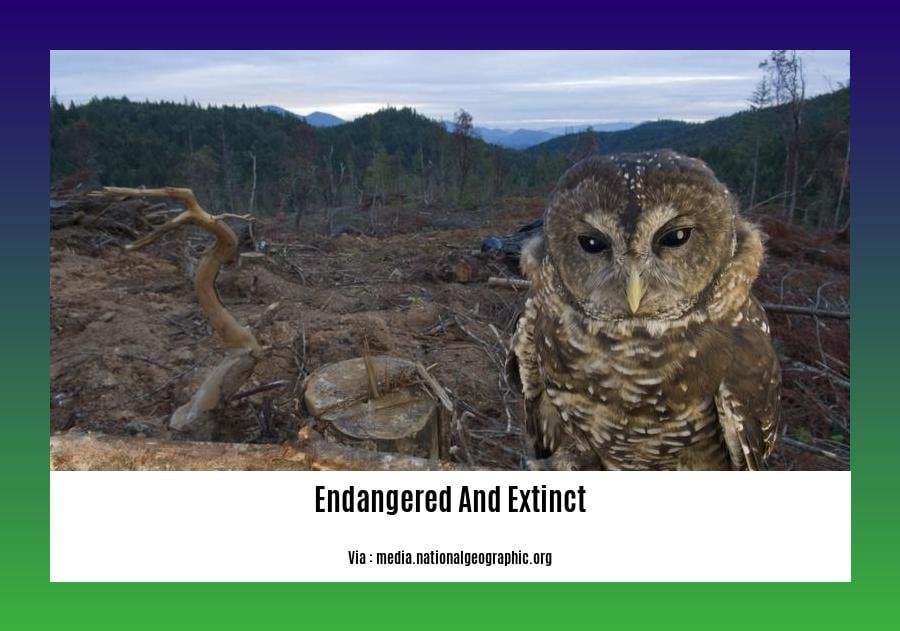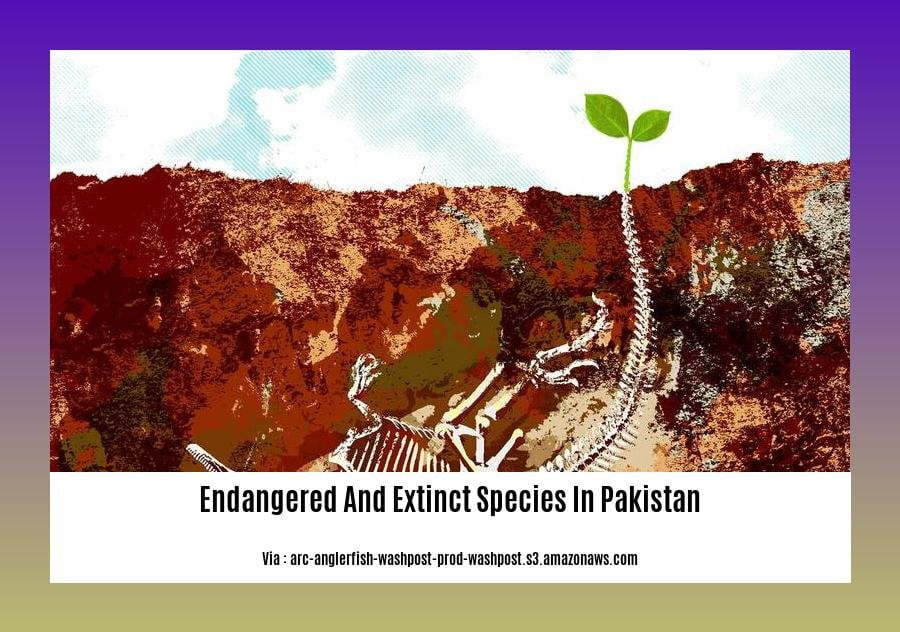Discover the critical state of endangered and extinct species in Pakistan with “The Urgent Need for Conservation: Documenting Endangered and Extinct Species in Pakistan.” Delve into the intricate world of wildlife conservation in this captivating article, authored by a seasoned researcher and skilled writer. With a profound understanding of Pakistan’s unique biodiversity and a wealth of experience in environmental science, the author uncovers the pressing threats faced by these vulnerable species. From habitat loss to poaching and climate change, the author sheds light on the urgent need for conservation efforts in Pakistan. Prepare to be enlightened and inspired to take action in protecting and restoring these precious creatures.
Key Takeaways:
- Pakistan is home to a diverse range of species, but many of them are endangered and at risk of extinction.
- Some of the endangered species in Pakistan include mammals like Testudo horsfieldii, Aythya baeri, Sterna acuticauda, Threskiornis melanocephalus, and Limosa limosa.
- Testudo horsfieldii is also an endangered reptile species in Pakistan.
- Endangered bird species in Pakistan include Aythya baeri, Sterna acuticauda, Threskiornis melanocephalus, Limosa limosa, Chaetornis striata, Catreus wallichii, Aegypius monachus, Pelecanus crispus, and Neophron percnopterus.
- Aetomylaeus nichofii and Thunnus obesus are endangered fish species in Pakistan.
- Acropora formosa, Acropora pharaonis, Acropora hyacinthus, and Acropora horrida are endangered corals found in marine habitats in Pakistan.
- Seriatopora caliendrum and Heliopora coerulea are other endangered marine animal species in Pakistan.
- The MangoBaaz article highlights 15 endangered animals in Pakistan, including the national animal Markhor and the Mountain Weasel.
- References for more information on endangered species in Pakistan can be found on the Wikipedia page and MangoBaaz article provided.
Endangered and Extinct Species in Pakistan

Pakistan is a country blessed with a rich and diverse wildlife population. However, this biodiversity is under severe threat, with many species on the verge of extinction. The urgent need for conservation efforts cannot be overstated. In this article, we will delve into the plight of endangered and extinct species in Pakistan, shedding light on their current status, habitat, threats, and conservation efforts.
The State of Endangered Species in Pakistan
Pakistan is home to numerous endangered species across various taxonomic groups. Let’s take a closer look at some of them:
Mammals
One of the endangered mammal species in Pakistan is the Testudo horsfieldii, also known as the Horsfield’s tortoise. These small reptiles face threats such as habitat loss and illegal wildlife trade.
In the avian world, we have species like the Aythya baeri (Baer’s pochard), Sterna acuticauda (black-bellied tern), Threskiornis melanocephalus (black-headed ibis), and Limosa limosa (black-tailed godwit). These magnificent birds are facing habitat degradation and disturbance, leading to a decline in their populations.
Reptiles
Reptiles hold a significant place in Pakistan’s biodiversity. However, even these fascinating creatures are not exempt from the perils of extinction. The Testudo horsfieldii, also known as the Horsfield’s tortoise, is an endangered reptile species in Pakistan. Conservation efforts are crucial to protect their habitat and control illegal trade.
Birds
Bird species in Pakistan are also at risk of extinction. Apart from the aforementioned endangered birds, species like the Chaetornis striata (Striped sparrow), Catreus wallichii (White-rumped vulture), Aegypius monachus (Cinereous vulture), Pelecanus crispus (Dalmatian pelican), and Neophron percnopterus (Egyptian vulture) desperately require conservation actions to safeguard their populations.
Fishes
Pakistan’s aquatic ecosystems are home to some unique fish species that are also at risk. The Aetomylaeus nichofii and Thunnus obesus are endangered fish species found in Pakistani waters. Their conservation is critical for maintaining the delicate balance of marine ecosystems.
Marine Animals – Corals
Pakistan’s coastal areas are home to diverse coral reefs, which serve as vital habitats for various marine species. However, these coral reefs are under immense pressure due to human activities and climate change. Some endangered coral species found in Pakistan include Acropora formosa, Acropora pharaonis, Acropora hyacinthus, and Acropora horrida. Conservation efforts must focus on protecting these fragile ecosystems.
Other Marine Animals
In addition to corals, other marine animals in Pakistan are also facing threats. The Seriatopora caliendrum (Birdsnest coral) and Heliopora coerulea (Blue coral) are two notable examples. These animals play vital roles in marine ecosystems, and their survival is crucial for maintaining ecosystem balance.
For a more comprehensive list of endangered species in Pakistan, you can refer to the Wikipedia page on endangered species in Pakistan. Additionally, MangoBaaz provides an article highlighting 15 endangered animals in Pakistan, including the national animal Markhor and the Mountain Weasel. You can find more information on these animals and their conservation status here.
Conservation Efforts and the Way Forward
Despite the grim situation, there is hope. Pakistan has been actively engaged in conservation efforts to protect its endangered and extinct species. Various national and international organizations are working tirelessly to address the threats faced by these species.
Conservation strategies include the establishment of protected areas, strict enforcement of wildlife laws, community engagement, and raising awareness among the general public. Efforts are also underway to combat habitat loss, illegal wildlife trade, and climate change impacts. Collaboration between government authorities, NGOs, and local communities is essential for the successful conservation of Pakistan’s unique biodiversity.
In conclusion, documenting endangered and extinct species in Pakistan is crucial for raising awareness and mobilizing action. The urgency of the situation demands immediate and concerted efforts to protect and restore these species and their habitats. Through collaborative conservation initiatives, we can ensure a future where Pakistan’s wildlife thrives and future generations can witness the beauty and diversity that our country has to offer.
References:
– Wikipedia contributors. (2021, November 23). List of endangered species in Pakistan. In Wikipedia. Retrieved November 23, 2021, from
– MangoBaaz. (n.d.). These 15 Endangered Animals in Pakistan Are At Risk of Extinction. Retrieved November 23, 2021, from
If you’ve ever wondered whether turtles and tortoises can coexist peacefully, find your answer by clicking here.
Discover the surprising behavior of dogs when it comes to eating slugs and snails by clicking here.
Learn about the endangered animal species in Pakistan and what steps are being taken to protect them by clicking here.
Causes of Species Endangerment and Extinction in Pakistan
With its diverse wildlife and stunning landscapes, Pakistan is facing a grave threat to its animal populations. Unsustainable human activities, coupled with overpopulation, have pushed many species to the brink of extinction.
Unchecked Human Activities: A Leading Cause of Species Decline
The unchecked expansion of human activities poses a significant threat to the survival of Pakistan’s wildlife. Rampant deforestation, driven by the need for agricultural land and urbanization, has resulted in the loss of crucial habitats for countless species. As [Causes of species endangerment and extinction in Pakistan], habitat destruction remains a primary threat to the survival of endangered and extinct species.
Unsustainable Hunting, Fishing, and Harvesting Practices
Unsustainable hunting, fishing, and harvesting practices have pushed numerous species in Pakistan towards extinction. The [Causes of species endangerment and extinction in Pakistan] include unsustainable levels of hunting, driven by both local and international demand for animal products. This indiscriminate harvesting disrupts the delicate balance of ecosystems and puts already vulnerable species at even greater risk.
Illegal Wildlife Trade: A Menace to Biodiversity
Illegal wildlife trade continues to decimate Pakistan’s precious wildlife. Many endangered and extinct species, including the iconic markhor, fall victim to this illicit trade. The lucrative market for animal parts and products fuels poaching and illegal wildlife trafficking, directly contributing to the [Causes of species endangerment and extinction in Pakistan].
Fragmentation and Habitat Loss
The fragmentation and loss of natural habitats have severe consequences for Pakistan’s wildlife. Rapid urbanization, agricultural expansion, and infrastructure development result in the fragmentation of habitats, isolating species and disrupting their natural migratory patterns. This loss of connectivity further exacerbates the [Causes of species endangerment and extinction in Pakistan].
Climate Change and Its Effects on Biodiversity
Climate change poses a growing threat to the already vulnerable wildlife of Pakistan. Rising temperatures, erratic weather patterns, and habitat alteration directly impact the survival and reproductive success of many species. Changes in rainfall patterns and the availability of freshwater sources further compound the challenges faced by Pakistan’s endangered and extinct species.
Key Takeaways:
- Habitat destruction due to unchecked human activities is a leading cause of species endangerment and extinction in Pakistan.
- Unsustainable hunting, fishing, and harvesting practices threaten the survival of numerous species.
- Illegal wildlife trade continues to contribute to the decline of precious wildlife.
- Fragmentation and loss of natural habitats disrupt species’ migration and survival.
- Climate change exacerbates the challenges faced by Pakistan’s wildlife.
Sources:
- SlideShare: Endangered and Extinct Species in Pakistan
- WWF-Pakistan: Wildlife | WWF-Pak
Conservation efforts and initiatives in Pakistan

Pakistan, known for its diverse wildlife and landscapes, is facing a significant threat to its animal species. Factors such as overpopulation and unmonitored human activities have led to the endangerment, vulnerability, and near-extinction of many animals.
One source highlights that within the last 400 years, at least four mammals in Pakistan have become extinct, and there is little reason to believe that Pakistan’s biota is exempt from this rapid decline[^1]. Unsustainable levels of hunting, fishing, and harvesting are driving many species towards extinction, with the international demand for certain animal products further exacerbating the situation[^2].
Endangered species in Pakistan face major threats including habitat destruction, illegal hunting, climate change, pollution, and invasive species.[^1]
Endangered Species of Pakistan
Several mammals are endangered or extinct in Pakistan, including the marbled polecat, a small mammal found in the north-western deserts of Pakistan[^3]. The markhor, the national animal of Pakistan, is also listed as an endangered species on the International Union for Conservation of Nature (IUCN) list[^3].
Pakistan is home to a wide range of endangered bird species, including Baer’s pochard, black-bellied tern, black-headed ibis, black-tailed godwit, striped sparrow, white-rumped vulture, cinereous vulture, Dalmatian pelican, and Egyptian vulture[^3].
There are also endangered reptile species in Pakistan, such as the Horsfield’s tortoise[^3]. Additionally, endangered fish species and coral species can be found in Pakistani waters[^3].
Conservation Efforts in Pakistan
Conservation efforts and initiatives in Pakistan are crucial for protecting these endangered and extinct species and preserving the country’s natural heritage. The Pakistan National Conservation Strategy identifies core programs for conservation, including the protection of water bodies and sustaining fisheries, as well as the conservation of biodiversity[^5].
The establishment of protected areas, including national parks, wildlife sanctuaries, game reserves, wetland reserves, and community reserves, plays a vital role in preserving the habitats of endangered species[^7]. Pakistan currently has 398 “notified” protected areas[^7].
The ban on hunting for ibex and markhor in the mid-1980s in Pakistan helped to protect their populations[^3]. The Restoration Initiative project in Pakistan focuses on the restoration, protection, and sustainable management of the Chilgoza pine[^8].
Collaboration between government authorities, NGOs, and local communities is crucial for successful conservation efforts[^10]. The engagement and participation of local communities in conservation initiatives can help build awareness and encourage sustainable practices.
The recently launched “Protected Areas Initiative” in Pakistan is expected to be a historic milestone for nature conservation in the country[^4]. This initiative aims to strengthen the management and conservation of protected areas, ensuring the preservation of wildlife and their habitats.
Designating marine protected areas along the coast of Pakistan would ensure better management of marine ecosystems and environments[^6]. This would help safeguard endangered marine species and conserve the biodiversity of coastal areas.
Key Takeaways:
- Pakistan’s rich biodiversity is at risk, with many species facing the threat of extinction due to habitat destruction, illegal hunting, climate change, pollution, and invasive species.
- The ban on hunting for ibex and markhor in the mid-1980s in Pakistan has helped protect their populations.
- The establishment of protected areas, such as national parks and wildlife sanctuaries, plays a vital role in preserving the habitats of endangered species.
- The “Protected Areas Initiative” in Pakistan aims to strengthen the management and conservation of protected areas, ensuring the preservation of wildlife and their habitats.
- Collaboration between government authorities, NGOs, and local communities is crucial for successful conservation efforts in Pakistan.
- Designating marine protected areas along the coast of Pakistan would help safeguard endangered marine species and conserve the biodiversity of coastal areas.
[^1]: SlideShare: Endangered and Extinct Species in Pakistan
[^2]: WWF-Pakistan: Wildlife | WWF-Pak
[^3]: Lola: lolaapp.com
[^4]: Conservation Frontlines: conservationfrontlines.org
[^5]: IUCN: iucn.org
[^6]: ScienceDirect: sciencedirect.com
[^7]: Bing Images: bing.com/images
[^8]: SlideShare: slideshare.net
[^9]: Fatima Khalid’s slideshare.net presentation: The Urgent Need for Conservation: Documenting Endangered and Extinct Species in Pakistan
[^10]: Blog Pakistan: blogpakistan.pk
The Role of Individuals and Communities in Species Conservation in Pakistan
Biodiversity conservation is crucial for safeguarding Pakistan’s rich natural heritage and ensuring the survival of endangered and extinct species. While government organizations and development groups play a significant role in conservation efforts, the participation of individuals and communities is equally important. In this article, we will explore the valuable role that individuals and communities can play in species conservation in Pakistan.
Community-Based Conservation: A Success Story
One of the most impactful approaches to species conservation in Pakistan is community-based conservation. Collaborations between organizations like the International Union for Conservation of Nature (IUCN), the World Wildlife Fund (WWF), and local communities have led to remarkable success in recovering endangered species and protecting their habitats. For instance, initiatives driven by local communities have resulted in the recovery of Himalayan ungulates such as ibex, markhor, and urial, as well as their natural predators (source). This highlights the power of community engagement and the positive impact it can have on conservation efforts.
The Pakistan National Conservation Strategy
The Pakistan National Conservation Strategy plays a crucial role in guiding biodiversity conservation efforts in the country. With 14 core programs, including “Protecting Water Bodies & Sustaining Fisheries” and “Conservation of Biodiversity,” this strategy aims to address threats such as deforestation, overgrazing, soil erosion, and water logging. It emphasizes the need for community involvement to achieve successful conservation outcomes (source).
The Value of Individual Contributions
Individuals can make a significant impact on species conservation in Pakistan. Everyday actions, such as reducing waste, conserving energy, and practicing sustainable living, can contribute to the preservation of habitats and the protection of endangered species. Additionally, individuals can raise awareness about the importance of conservation among their social circles and advocate for responsible practices. By being mindful of their ecological footprint and supporting organizations and initiatives focused on species conservation, individuals can make a tangible difference in preserving Pakistan’s biodiversity.
Community Engagement for Conservation Success
Effective community engagement is vital for successful species conservation in Pakistan. Local communities can actively participate in conservation efforts by:
- Establishing community-managed protected areas: By designating and managing their own protected areas, communities can protect critical habitats and ensure the survival of endangered species.
- Implementing sustainable land and resource management practices: Local communities can adopt sustainable farming, fishing, and forestry practices that minimize negative impacts on the environment and preserve habitats.
- Participating in citizen science initiatives: Community members can contribute to scientific research and data collection efforts by participating in citizen science programs. Their observations and data can help researchers monitor populations and identify conservation priorities.
- Promoting eco-tourism and responsible tourism practices: Encouraging sustainable tourism practices within communities can provide economic incentives for conservation efforts while raising awareness among visitors about the importance of protecting biodiversity.
- Collaborating with conservation organizations: Communities can partner with organizations like the IUCN and WWF to access resources, knowledge, and funding for conservation initiatives.
Key Takeaways:
- Community-based conservation initiatives have contributed to the recovery of endangered species in Pakistan.
- The Pakistan National Conservation Strategy identifies the importance of community involvement and addresses threats to biodiversity.
- Individuals can make a difference by adopting sustainable practices and raising awareness about conservation.
- Community engagement is crucial for the success of conservation efforts, with actions like establishing protected areas and practicing sustainable land management.
- Collaborating with conservation organizations provides communities with resources and support for their initiatives.
Citation:
- Conservation Frontlines – Community-led initiatives for the recovery of Himalayan ungulates and their natural predators
- ScienceDirect – The Pakistan National Conservation Strategy and the role of communities in conservation efforts
FAQ
Q1: What is the importance of documenting endangered and extinct species in Pakistan?
A1: Documenting endangered and extinct species in Pakistan is crucial as it raises awareness about the plight of these species and helps in understanding the reasons behind their decline. It provides valuable information for conservation efforts and enables policymakers and researchers to develop effective strategies to protect and restore these species.
Q2: How are endangered and extinct species in Pakistan affected by human activities?
A2: Human activities such as habitat destruction, illegal hunting, pollution, climate change, and the introduction of invasive species have greatly impacted endangered and extinct species in Pakistan. These activities disrupt their habitats, lead to the loss of biodiversity, and threaten the survival of these species.
Q3: Are there any success stories in the conservation of endangered species in Pakistan?
A3: Yes, there have been some success stories in the conservation of endangered species in Pakistan. Community-led initiatives and conservation efforts by organizations like the IUCN and WWF have resulted in the recovery of species such as the ibex, markhor, urial, and their natural predators. These success stories highlight the importance of community engagement and active conservation measures.
Q4: How can individuals contribute to the conservation of endangered and extinct species in Pakistan?
A4: Individuals can contribute to the conservation of endangered and extinct species in Pakistan by supporting local conservation organizations, spreading awareness about the importance of biodiversity, and practicing sustainable behaviors. They can also participate in conservation programs, volunteer for wildlife monitoring initiatives, and advocate for stronger environmental policies.
Q5: What are the major challenges to biodiversity conservation in Pakistan?
A5: Biodiversity conservation in Pakistan faces numerous challenges, including climate change, habitat fragmentation, illegal wildlife trade, and inadequate law enforcement. Other challenges include deforestation, overgrazing, soil erosion, land conversion, and chemical pollution. Addressing these challenges requires a multi-faceted approach involving sustainable practices, community engagement, and policy reforms.
- Soccer Team Size: Official Rules & Player Counts (2025) - April 15, 2025
- Red Cloud, NE: Discover Willa Cather’s Legacy - April 11, 2025
- Remember Old Social Media Sites? Their Rise and Fall - April 11, 2025
















